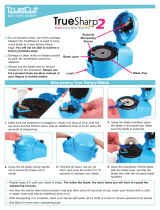
3
The Toro warning system in this manual identifies
potential hazards and has special safety messages that help
you and others avoid personal injury, even death.
DANGER, WARNING and CAUTION are signal words
used to identify the level of hazard. However, regardless
of the hazard, be extremely careful.
DANGER signals an extreme hazard that will cause
serious injury or death if the recommended precautions
are not followed.
WARNING signals a hazard that may cause serious injury
or death if the recommended precautions are not followed.
CAUTION signals a hazard that may cause minor or
moderate injury if the recommended precautions are not
followed.
Two other words are also used to highlight information.
“Important” calls attention to special mechanical
information and “Note” emphasizes general information
worthy of special attention.
The left and right side of the machine is determined by
standing behind the handle in the normal operator’s
position.
Safety
This machine meets or exceeds CPSC blade safety
requirements for walk–behind rotary mowers and the
B71.4 specifications of the American National
Standards Institute, in effect at time of production.
However, improper use or maintenance by the
operator or owner can result in injury. To reduce the
potential for injury, comply with these safety
instructions and always pay attention to the safety alert
symbol which means CAUTION, WARNING or
DANGER—“personal safety instruction.” Failure to
comply with the instruction may result in personal
injury.
WARNING
POTENTIAL HAZARD
• Engine exhaust contains carbon monoxide,
which is an odorless, deadly poison.
WHAT CAN HAPPEN
• Carbon monoxide can kill you and is also
known to the State of California to cause birth
defects.
HOW TO AVOID THE HAZARD
• Do not run engine indoors or in an enclosed
area.
Safe Operating Practices
This product is capable of amputating hands and feet and
throwing objects. Always follow all safety instructions to
avoid serious injury or death.
This mower is designed for cutting and recycling grass or,
when equipped with a grass bag, for catching cut grass.
Any use for purposes other than these could prove
dangerous to the operator or bystanders.
Note: This engine is NOT equipped with a spark arrester
muffler. Use or operation of this mower in the State of
California on any forest-covered, brush-covered or
unimproved grass-covered land, without an approved
spark arrester muffler, is a violation of the law. Other
states may have similar laws.
General Operation
• Read this manual carefully before operating the
mower. Become familiar with the controls and proper
use of the mower. Never allow children under 16 years
of age to operate the mower. Never allow adults to
operate mower without proper instructions.
• The operator of the mower is responsible for keeping
everyone, especially children and pets, away from area
of operation. The operator is responsible for accidents
or hazards occurring to other people or their property.
• Thoroughly inspect the area where the mower will be
used and remove sticks, stones, wire, and debris that
could be picked up and thrown by the mower. Watch
for foreign objects while mowing.
• Wear long pants and substantial shoes. Do not operate
the mower while wearing open-toed shoes, jewelry,
loose clothing, or when barefoot.
• Check the fuel level before starting the engine.
Because fuel is highly flammable, handle it carefully.
• Use an approved fuel container.
• Fill the fuel tank outdoors, not indoors. Never add
fuel to an engine that is running or hot.
• Install a gas cap on the fuel container and gas tank,
and wipe up any spilled gasoline before starting the
engine.
• Do not smoke while refueling.
• Keep all guards, shields, safety devices,
cover-deflector assembly, optional grass catcher,
optional side discharge chute, and/or optional
discharge tunnel plug in place. Repair or replace
damaged parts, including decals. Check all safety
devices before each use.




















